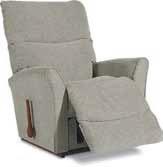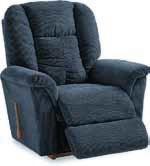
































Windows in a home are easy to take for granted. Unless windows are showing signs of wear and tear or so dirty that it’s hard to see through



them, it’s easy for them to go unnoticed. However, replacement windows can add value to a home and even save homeowners a substantial amount
of money. Much of the savings that can be attributed to new windows is related to energy effciency. The Offce of Energy Effciency and Renewable Energy estimates that as much as 30 percent of heating and cooling energy can be lost through heat gain or heat loss, and aging, ineffcient windows contribute to such losses. Replacing those windows can save homeowners substantial amounts of money, with one expert at Angi estimating that installation of energy effcient windows can help trim energy bills by as much as 12 percent. Cost savings are often noted when frms promote replacement windows, but homeowners should know that replacement windows also
provide numerous additional benefts. In fact, the following are three great reasons for homeowners to consider upgrading their windows today.
1. New windows help reduce carbon footprint. The U.S. Environmental Protection Agency reports that replacing single-pane windows with ENERGY STAR® certifed windows can help to reduce CO2 emissions by a signifcant margin. The EPA reports that such windows can save the equivalent of as much as 6,200 pounds of CO2 emissions thanks to reduced energy consumption associated with the new windows.
2. New windows can brighten a home. Natural light brightens a room and can make it appear larger. Home-
owners who have grown accustomed to old windows may not realize how little light such windows let into their homes. Aging windows can become foggy over time and prevent natural light from getting into a home. That can create a gloomy feel and force homeowners to turn up the thermostat on cold days. New windows brighten the home and the natural light that pours in on a cold day can help heat the home at the same time.
3. New windows cut down on noise. Window manufacturers are always on the lookout for ways to produce windows that make homes more comfortable. Noise reduction is one way to accomplish that goal, and Consumer Reports notes that triple-glazed



windows can help to dramatically reduce outside noise. Homeowners who currently have single-pane windows may be astonished by the difference in outside noise levels when upgrading to triple-glazed windows, which contain a third layer of glass. That third layer of glass signifcantly reduces noise levels, making triple-glaze windows ideal for homes on busy streets or those in urban areas with lots of foot traffc. Replacement windows pay numerous dividends. Homeowners can reap these rewards and others by replacing aging windows.

Houses typically feature various areas that are traditionally designed for storage, such as garages, basements and attics. However, with some renovation, these spaces can be transformed into livable areas.




Homeowners who would like to convert attics into livable spaces need to take certain things into consideration before starting an improvement project.
While the attic may seem like it has plenty of room and is structurally sound enough to walk in, that’s not necessarily so. To be converted into usable living space, an attic must be brought up to the standards of modern building codes, according to the design experts at Board & Vellum. Retroftting beams and insulation can eat up available space in an attic. Thus, it is best to consult an expert to see if an attic can be converted.
Furthermore, an attic that was not initially designed as a room when



the house was built can add extra “load” upstairs if it is converted. That could present certain structural problems. That means a structural engineer also must be consulted to see if adding beams, fooring and drywall will necessitate other changes elsewhere in the home to accommodate the extra load.




In order to have a functional attic room, building codes will dictate that it needs to be accessible by a full-size staircase. Also, it will need to have another exit in case of an emergency so that will likely be an accessible window, according to the home information site The Fill.


Homeowners’ budgets and renovation plans will need to factor into these considerations.


Homeowners also are advised to check local permits to determine what else may be required to go forward. It is best to follow the rules. Lack of a permit for work can affect the ability to sell a home down the line.


Individuals also should plan for heating and cooling upgrades as the home will need to have ductwork installed in the attic, or at the least, a stand-alone heating and cooling unit. As heat rises, it can get quite warm in an attic, so ventilation and comfort should be considered. The attic will need to be wired for electricity for lighting and other needs. Air sealing and additional insulation can the attic


space more comfortable as well. Consult with a qualifed electrician and an HVAC technician and have an energy audit done to discuss needs.
Attic renovations can give homeowners more space in their homes, which can be used as offces, bedrooms or cozy corners. This is no small undertaking and all of the right steps need to be followed to ensure a legal, safe and successful renovation.

Nice fooring draws immediate attention when entering a home. Natural wood foors tend to instantly impress, while the right kitchen fooring materials can create the welcoming feeling many homeown-



ers strive to establish in the most popular room in the home.













Stunning foors are hard to miss, and foors that are well past their prime are equally noticeable. Aging foors may fall somewhere between


fading and failing to live up to homeowners’ standards. Fading foors may not need to be replaced immediately, but the following are some signs that indicate existing foors are nearing their expiration date.


• Soft spots: A foor should not give when stepped on. Soft spots could be indicative of water damage caused by any number of factors. Some water damage is caused by mopping the foor with a soaking wet mop, while burst pipes also contribute to water damage that can cause soft spots. A single soft spot on the foor may necessitate a relatively simple repair, but vari-
ous soft spots indicate extensive damage that might be affecting the foor, subfooring or both. In the latter instance, homeowners should consider a full foor replacement.
• Creaking foors: Creaking foors are among the more annoying issues that can arise in a home. In such homes, residents feel as though every step they or their housemates take is being announced. In addition, creaking foors can awake light sleepers, including young children. The foor experts at Discount Flooring Depot note that uneven subfoor could be the culprit behind creaking

foors. Though that does not necessarily require a foor replacement, it can be hard to lift existing foors and then reft them after the subfooring has been addressed. That’s especially so if low-quality laminate fooring was installed. So while creaking foors may not require a full foor replacement, it’s an outcome homeowners who can no longer live with the noise can prepare themselves for.

• Dated look: Of course, some foors simply look like the product of a bygone era. Various factors, including location, affect the resale value of a home, but Realtor.com reports










that hardwood foors are preferred by both home buyers and renters. In addition, Realtor.com estimates that wood foors could provide a return as high as 80 percent of the initial investment when homeowners sell their homes. If existing fooring looks dated, it might be time to bring it up to speed with something more modern. A home’s fooring is bound to draw the attention of residents and visitors alike. Homeowners who replace their fooring can ensure that attention is drawn for all the right reasons.

Kitchens are the busiest rooms in most homes. Kitchens have become more than just places to prepare meals, with many functioning as gathering spaces and even go-to dining spots in homes that do not feature formal dining rooms.
So much time spent in the kitchen makes it worthwhile to invest in these popular spaces. Kitchen renovations are high on many homeowners’ to-do lists, and there’s many decisions to make once they commit to redoing the room. When renovating a kitchen, homeowners will have to choose which countertop material they want to install, and the following rundown of popular options
can help simplify that decision.
Quartz
Quartz is considered a low-maintenance and durable countertop material. The home improvement experts at This Old House note that quartz countertops are typically 94 percent ground quartz and now come with an honed, sandblasted or embossed treatment, which makes them appealing to homeowners with varying ideas on the ideal look of a kitchen countertop. Quartz can crack if it’s not handled properly, and edges and corners can chip over time. Rounded edges can minimize the risk of chipping. Costs vary by location and product
availability, but quartz typically costs about the same as natural stone.





Granite
Consumer Reports notes that no two slabs of granite are the same, and that uniqueness has long appealed to homeowners. Tests run by Consumer Reports found that heat, cuts and scratches did not harm granite, though this material, like quartz, can crack around edges and corners. Granite is a durable material that, if properly maintained, can last several decades. Granite also is nonporous, which makes it resistant to bacteria.

Laminate Laminate countertops appeal to budget-friend-



















ly homeowners and Consumer Reports notes that they’re easy to install. Home Depot also notes that laminate countertops come in a wide range of colors, textures and designs. Laminate countertops also are durable, which helps budget-conscious homeowners stretch their dollars even further. Laminate countertops are easily maintained, though it’s also easy to permanently damage them with knives, so Consumer Reports recommends always using a cutting board when preparing meals on laminate.

Butcher Block Butcher block countertops are among the more unique options homeowners may con-
sider. Sometimes referred to as “wood countertops,” butcher block countertops are made from wooden strips that are fused together. The home improvement experts at BobVila.com note that butcher block is among the more affordable materials, but the fnal cost will be dictated by location and availability. BobVila. com notes that butcher block countertops are highly sensitive to liquid, so exposure to moisture should be limited. Sealing butcher block countertops immediately after installation can help protect against bacteria and warping. Though butcher blocks can be high maintenance, many homeowners fnd the unique look
is well worth the extra elbow grease. Kitchen countertops can defne how the room looks, and homeowners have many options to choose from when designing a new kitchen.
Home renovations provide a host of benefts. Such projects can increase resale value and improve on the safety, aesthetics and functionality of a home.

Some homeowners may employ the mantra “go big or go home” when they embark on home improvements, thinking that only the largest renovations produce noticeable change. But that’s not the case. Various smaller renovations can provide a lot of bang for homeowners’ bucks as well.


• Countertops (and hardware): A complete kitchen overhaul may stretch some homeowners’ budgets. However, changing an older countertop for a new material can provide the facelift a kitchen needs. And while changing the cabinets may
be homeowners’ ultimate goal, swapping hardware in dated fnishes for newer handles and pulls can provide low-cost appeal.
• Paint: Painting a space is an inexpensive improvement that adds maximum impact. Paint can transform dark and drab rooms into bright and airy oases. Paint also can be used to create an accent wall or cozy nooks. Homeowners also can showcase their personalities with their choice of paint colors.
• Lighting: Homeowners should not underestimate what a change in lighting can do. When rooms or exterior spaces are illuminated, they take on entirely new looks. It’s worth it to invest in new lighting, whether it’s a dramatic hanging light over the dining room table
or task lighting in dim spaces.
• Weatherproofng: Improving windows, doors, weatherstripping, and insulation in a home can offer visual appeal and help homeowners save money. The initial investment may be signifcant, but those costs will pay off in energy savings. According to One Main Financial, space heating is the largest energy expense the average American homeowner has, accounting for around 45 percent of all energy costs.
• Mudroom: Turn an entryway into a more functional space with the addition of cabinets, benches or custom-designed storage options that perfectly ft the area. Cubbies and cabinets can corral shoes, umbrellas,
hats, bags, and much more.
• Accent updates: Any space, whether it’s inside or outside a home, can get a fresh look with new decorative accents. Invest in new throw pillows and even slipcovers for living room so-
fas. Use new tile or paint the brick on a freplace in a den, then update the mantel with decorative displays. Purchase wall art that can bring different colors into a room. Change the cushions on deck furniture and buy color-coor-
dinated planters. These subtle changes will not cost as much as full-scale renovations, but they can still help homeowners transform their homes.



